User:S4188552: Difference between revisions
| Line 76: | Line 76: | ||
10. [http://www.ncbi.nlm.nih.gov/pmc/articles/PMC4374535/ Thuy Do, Sheehy EC, Tonnie M, Hughes F, Beighton D (2015) Transcriptomic analysis of three Veillonella spp. present in carious dentine and in the saliva of caries-free individuals. Front Cell Infect Microbiol. <b>5</b:25.] | 10. [http://www.ncbi.nlm.nih.gov/pmc/articles/PMC4374535/ Thuy Do, Sheehy EC, Tonnie M, Hughes F, Beighton D (2015) Transcriptomic analysis of three Veillonella spp. present in carious dentine and in the saliva of caries-free individuals. Front Cell Infect Microbiol. <b>5</b:25.] | ||
11. [https://www-ncbi-nlm-nih-gov.ezproxy.library.uq.edu.au/pubmed/3904599 Delwiche EA, Pestka JJ, Tortorello ML (1985) The veillonellae: gram-negative cocci with a unique physiology. Ann. Rev. Microbiol <b>39</b>:175-93] | |||
<references/> | <references/> | ||
This page is written by Aimee Davidson for the MICR3004 course, Semester 2, 2016 | This page is written by Aimee Davidson for the MICR3004 course, Semester 2, 2016 | ||
Revision as of 01:11, 21 September 2016
Aimee Davidson Bench E Date [1]
Classification
Higher order taxa
Kingdom - Bacteria - Firmicutes - Negativicutes - Selenomonadales - Veillonellaceae - Veillonella [3]
Species
Species name: Veillonella parvula (subspecies parvula) [3]
Type strain: ATCC 10790 = CCUG 5123 = DSM 2008 = JCM 12972 = NCTC 11810 [3]
Description and significance
Veillonella parvula is one of thirteen species of the ‘’Veillonella’ genus and one of only six of these species to be found within the human oral cavity [6]. It was original dubbed Staphylococcus parvulus by Veillon and Zuber following its first isolation from an infected human appendix in 1898 [11]. It was subsequently renamed Veillonella parvula in 1933 by Prevot [11].
It is small gram-negative cocci that can be identified by its characteristic pair grouping and distinctive red fluorescence under UV light [4]
.
Genome structure
V. parvula exhibits a circular 2.13 Mb (2,132,142 bp) genome, of which 88.46 % is DNA encoding, and was the first member of the Veillonella family to have its complete genome sequenced. Its 1920 genes include: 1859 protein-encoding genes, 61 RNA specific genes and 15 pseduogenes, with an overall GC content of 38.63%. The majority of these genes are predicted to have either an unknown (385 genes) or general function (177 genes). Although those genes with a predicted function are predominately involved with: translation, ribosomal structure, cell wall or membrane biogenesis, energy production and conversion, amino acid, coenzyme and inorganic transport and metabolism [5].

Cell structure and metabolism
Cell wall, biofilm formation, motility, metabolic functions.
Ecology
It is a strict anaerobe whose metabolic activity is centred upon the activity of the methylmalonyl-COA decarboxylase enzyme.
Pathology
V. parvula has a well established association with human oral diseases, in particular demonstrating a strong association with severe early childhood carries and intraradicular infections [5],[6]. Recent research has also revealed that V. parvula is the predominant Veillonella species within dentine biofilms[10].
Although V. parvula generally presents as a commensal or non-pathogenic resident in the bacterial communities of the oropharynx and the gastrointestinal, genitourinary and respiratory tracks [7]
, it has rarely been associated with a number of serious and life-threatening infections. These infections include: osteomyeltitis, spondylodiscitis, discitis, meningitis and sinus infections [7], [8].
It has demonstrated resistance against a wide range of antibiotics including: tetracycline, erythromycin, gentamicin, karamycin, chloramphenicol and lincomycin. Although importantly at the time of its genome sequencing in 2010 it was still susceptible to penicillin, cephalotin and clindamycin [5].
Application to biotechnology
Bioengineering, biotechnologically relevant enzyme/compound production, drug targets,…
Current research
Summarise some of the most recent discoveries regarding this species.
References
References examples
3. List of prokaryotic names with standing in nomenclature
- ↑ MICR3004
This page is written by Aimee Davidson for the MICR3004 course, Semester 2, 2016
